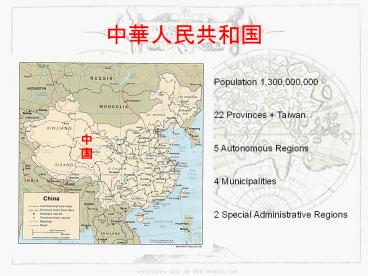China ??????? - PowerPoint PPT Presentation
1 / 8
Title:
China ???????
Description:
Title: China Author: RHIT Last modified by: RHIT Created Date: 2/17/2004 11:26:30 AM Document presentation format: On-screen Show – PowerPoint PPT presentation
Number of Views:81
Avg rating:3.0/5.0
Title: China ???????
1
???????
Population 1,300,000,000 22 Provinces
Taiwan 5 Autonomous Regions 4 Municipalities 2
Special Administrative Regions
??
2
Some inventions/discoveries of the Chinese prior
to the 15th Century Europe entry (century) 1.
The horse collar 3rd BC 6 2. The wheelbarrow 1st
BC 113. The moldboard plow 3rd BC 17 4. Paper
money 9th 17 5. Cast iron 4th BC 7 6. The
helicopter rotor and the propeller 4th 19 7. The
decimal system 14th BC 9 8. The seismograph 2nd
19 9. Matches 6th 16 10. Circulation of the
blood 2nd BC 17 11. Paper 2nd BC West Asia 8
manufactured in Europe 12 12. Brandy and Whiskey
7th 1213. The Kite 4th BC 16 14. The rocket
and multi-staged rockets 11th 14
Chinese have great pride in their past, great
frustrations about their relationships with the
West, and great patience for the future.
3
Recent Historic Junctures
1953-57 Five-Year Plan 1958-60 Great Leap
Forward 1966-76 Cultural Revolution 1989
Tiananmen Demonstration
1800 Qing Dynasty (Manchu) 1839-42 Opium
War/unequal treaties 1912 Republic of China, Sun
Yat-sen followed by rule of landed warlords 1921
Communist Party founded 1927 Civil War 1934 Long
March 1937 Japanese invasion 1949 Communist
victory 1976 Mao Dies
Landlords, collectives, communes, and riches
4
6th largest GDP (12 of world total), purchasing
parity 2nd, 1980-2000 avg. income increased 15
fold But income not equitably distributed----
officially 7.8 million unemployed, health care,
retirement, schools threatened for poorer
segments of population
5
Government
President Vice President
C C P
Premier, Vice-Premiers
Central Military Commission
Supreme Peoples Court
National Peoples Congress
State Council
Ministries, Commissions, Bureaus, etc.
Supreme Peoples Procuratorate
Provincial, City, Local, Peoples Governments
Provincial, City, Local, Peoples Congress
guanxi
6
Democratic idea
Peoples Republic of China ??????? Democracy
???? What is democracy?
Socialist Democracy Competitive Democracy
What role should elections have in a democracy?
7
Although they remain subordinate to the CCP, the
various government bodies and other organizations
discussed in this section should not be
dismissed. They do provide important access
points between the Party and the organized
masses, which allow the voicing of special
interests in ways that do not threaten Party
hegemony and yet pressure the shaping of
policy. From page 662
8
Amnesty International
China 2002
Covering events from January - December
2002 Serious human rights violations continued
and in some respects the situation deteriorated.
Tens of thousands of people continued to be
arbitrarily detained or imprisoned for peacefully
exercising their rights to freedom of expression,
association or belief. Some were sentenced to
prison terms many others were administratively
detained without charge or trial. The "strike
hard" campaign against crime launched in April
2001 was renewed for a further year. According to
interim figures available, the crack-down led to
at least 1,921 death sentences, many imposed
after unfair trials, and 1,060 executions.
Torture and ill-treatment remained widespread and
appeared to increase as a result of the campaign.
The anti-crime crack-down also extended to people
accused of being "ethnic separatists",
"terrorists" and "religious extremists" in the
Xinjiang Uighur Autonomous Region (XUAR) and
members of the Falun Gong spiritual movement.
Further regulations were introduced to control
access to the Internet. Labour protests increased
and were frequently met with excessive use of
force and arbitrary detentions. In Xinjiang,
restrictions increased on the cultural and
religious rights of the mainly Muslim Uighur
minority. In Tibet, freedom of expression and
religion continued to be severely restricted,
although seven prisoners of conscience were
released before the end of their sentences.































